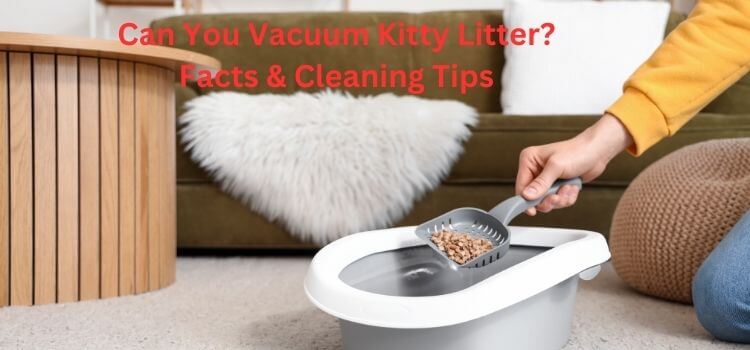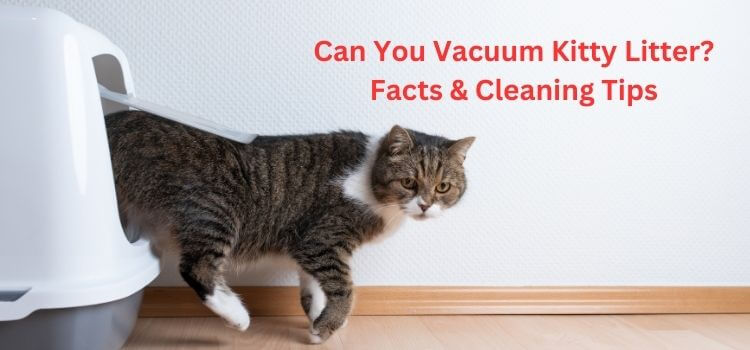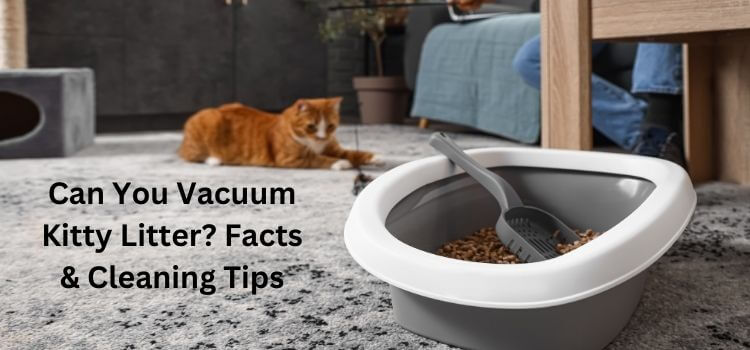As an Amazon Associate, I earn from qualifying purchases
Cats are among the most well-liked pets in the world because of their low maintenance requirements, loving disposition, and independence. They are a source of companionship, stress relief, and even pest management assistance. But one of the pleasures of owning a cat also entails the duty of keeping your home tidy and sanitary, especially when it comes to handling cat litter.
The Challenge of Managing Kitty Litter
One of the biggest challenges for cat owners is dealing with kitty litter. It can be messy, dusty, and sometimes odorous. The frequent need to clean and dispose of used litter can become a daunting task. This has led many cat owners to explore different methods of managing kitty litter, including the possibility of vacuuming it.
Importance of Proper Kitty Litter Disposal
Proper disposal and maintenance of kitty litter are crucial for several reasons. It helps maintain a clean and odor-free home, reduces the risk of health issues for both humans and cats, and minimizes environmental impact. Understanding the best ways to handle kitty litter, including whether it can be vacuumed, is essential for any cat owner.

What is Kitty Litter?
Definition and Purpose
Kitty litter is a material used in litter boxes to absorb and cover cat urine and feces, providing a sanitary area for cats to relieve themselves indoors. It helps control odors, makes cleaning easier, and offers a comfortable substrate for cats.
Common Types of Kitty Litter
There are several types of kitty litter available, each with its unique characteristics and benefits. The main categories include clumping and non-clumping litter, clay-based litter, silica gel litter, and natural or biodegradable options.
Types and Categories of Kitty Litter
Clumping vs. Non-Clumping
Clumping litter is designed to form solid clumps when it comes into contact with moisture, making it easier to scoop out waste without changing the entire litter box. Non-clumping litter absorbs moisture but does not form clumps, requiring more frequent complete changes of the litter box.
Clay-Based Litter
Clay-based litter is one of the most popular types due to its high absorbency and clumping capabilities. However, it can be dusty and is not biodegradable, raising environmental concerns.
Silica Gel Litter
Silica gel litter consists of small, crystal-like beads that absorb moisture and control odors effectively. It is low-dust and long-lasting but can be more expensive than other types.
Natural and Biodegradable Options
Corn
Corn-based litter is biodegradable, environmentally friendly, and has good clumping properties. It is also low in dust, making it a popular choice for eco-conscious cat owners.
Wheat
Wheat-based litter is another biodegradable option with natural clumping abilities. It is gentle on cats’ paws and controls odors effectively.
Pine
Pine litter is made from recycled wood and has a pleasant, natural scent. It is biodegradable and available in both pellet and granule forms.
Recycled Paper
Recycled paper litter is made from paper products and is highly absorbent. It is biodegradable, low-dust, and gentle on cats’ paws, though it may need to be changed more frequently.
Pros and Cons of Different Kitty Litters
Clumping Litter
Pros
Cons
Non-Clumping Litter
Pros
Cons
Environmental Impact of Various Litter Types
Different types of kitty litter have varying impacts on the environment. Clay-based litters, for example, are not biodegradable and contribute to landfill waste. Natural and biodegradable litters like those made from corn, wheat, pine, and recycled paper are more eco-friendly options, breaking down more easily and reducing environmental impact.

Symptoms and Signs of Kitty Litter Issues
Dust and Allergies
Dust from certain types of kitty litter can cause respiratory issues and allergies in both cats and humans. Symptoms include sneezing, coughing, and watery eyes.
Odor Problems
Poor odor control can lead to unpleasant smells spreading throughout the home. This is often a sign that the litter needs to be changed more frequently or that a different type of litter might be more effective.
Tracking Litter Around the House
Cats can track litter outside the box, spreading it around the house. This is a common issue, especially with lightweight and non-clumping litters.
Health Impacts on Cats
Cats may experience health issues related to kitty litter, such as urinary tract infections, respiratory problems from dust, or allergies to certain litter materials.
Causes and Risk Factors
Dust Creation from Kitty Litter
Some litters, particularly clay-based ones, generate significant dust, which can be inhaled by both cats and humans, leading to respiratory issues and allergies.
Chemical Additives in Litter
Chemical additives used to enhance odor control or clumping can cause allergic reactions or health problems in sensitive cats and humans.
Improper Ventilation
Poorly ventilated areas where litter boxes are placed can exacerbate odor and dust problems, increasing the risk of respiratory issues.
Multiple Cats in One Household
Households with multiple cats require more frequent litter changes and maintenance to manage odors and waste, increasing the complexity of litter management.
Diagnosis and Tests for Kitty Litter Problems
Identifying Allergies and Respiratory Issues
If you or your cat experience symptoms like sneezing, coughing, or watery eyes, it may be necessary to identify whether the litter is the cause. Switching to a low-dust, hypoallergenic litter can help determine if the symptoms improve.
Litter Box Placement Analysis
The placement of the litter box can impact how well odors and dust are managed. Conducting an analysis of different locations in your home can help find the optimal spot.
Evaluating Litter Types for Odor Control
Testing different varieties of litter to see which controls odors best in your specific living situation can help manage smells more effectively.
Monitoring Cat Health Related to Litter Use
Regular vet check-ups and monitoring your cat’s health can help identify any issues related to the type of litter being used. If problems are detected, a change in litter type might be recommended.
Treatment Options for Kitty Litter Problems
Switching Litter Types
One of the simplest solutions to kitty litter problems is to try a different type of litter. Natural, biodegradable options can reduce dust and chemical exposure.
Adding Air Purifiers
Using air purifiers near the litter box area can help reduce dust and odors, improving air quality in your home.
Improving Litter Box Hygiene
Regular cleaning and maintenance of the litter box, including daily scooping and periodic full changes, are essential for controlling odors and ensuring a healthy environment for your cat.
Consulting with Veterinarians
If your cat shows signs of health problems related to litter use, consulting with a veterinarian can provide insights and recommendations for alternative litter types or additional health measures.

Preventive Measures for Kitty Litter Issues
Regular Cleaning and Maintenance
Maintaining a clean litter box through regular scooping and changing the litter is crucial for preventing odors and health issues.
Choosing Low-Dust Litter Options
Opting for low-dust litter can reduce respiratory problems for both cats and humans, making for a healthier living environment.
Proper Litter Box Placement
Placing the litter box in a well-ventilated, easily accessible area can help manage odors and make cleaning easier.
Using Litter Mats to Reduce Tracking
Litter mats placed outside the box can help catch litter tracked by cats, reducing the spread of litter around your home.
Can You Vacuum Kitty Litter?
The Feasibility of Vacuuming Kitty Litter
Vacuuming kitty litter is a convenient solution for cleaning up scattered litter around the house. However, it is essential to consider the type of vacuum and the litter being used.
Vacuum Types Suitable for Kitty Litter
Not all vacuums are designed to handle kitty litter. Shop vacuums and those with strong suction and robust filters are better suited for this task. Avoid using regular household vacuums, as they may not be equipped to handle the abrasive nature of litter granules.
Pros and Cons of Vacuuming Kitty Litter
Pros
Cons
Step-by-Step Guide to Vacuuming Kitty Litter
- Choose the Right Vacuum: Use a shop vacuum or a vacuum with a strong suction and durable filters.
- Prepare the Area: Remove large clumps of litter manually before vacuuming.
- Vacuum Slowly: Move the vacuum slowly to allow it to pick up all the litter without scattering it further.
- Empty the Vacuum: Regularly empty the vacuum to prevent clogging and maintain suction power.
- Clean the Vacuum: After use, clean the vacuum to remove any residual litter particles and maintain its efficiency.
Personal Stories or Case Studies
Cat Owners’ Experiences with Different Litter Types
Many cat owners have shared their experiences with various types of litter. For instance, some found that switching to biodegradable litter significantly reduced dust and odor, while others appreciated the convenience of clumping litter despite its higher cost.
Success Stories of Vacuuming Kitty Litter
Several cat owners have successfully integrated vacuuming into their litter maintenance routine. For example, one owner reported that using a shop vacuum not only made cleanup faster but also improved air quality by reducing dust.
Challenges Faced and Overcome by Cat Owners
Challenges such as dealing with persistent odors and health issues prompted some cat owners to experiment with different litter types and maintenance techniques. Vacuuming, along with regular cleaning and using air purifiers, helped them achieve a cleaner and healthier environment for their cats.
Expert Insights
Veterinarian Opinions on Kitty Litter
Veterinarians often recommend using low-dust, hypoallergenic litter to prevent respiratory issues in cats. They also emphasize the importance of regular litter box maintenance to avoid health problems.
Pet Care Experts’ Tips on Managing Litter
Pet care experts suggest trying different litter types to find the best fit for your household and using litter mats to minimize tracking. They also recommend using a suitable vacuum to manage scattered litter effectively.
Environmentalists’ Views on Eco-Friendly Litter Options
Environmentalists advocate for using biodegradable litter options to reduce landfill waste and minimize environmental impact. They also highlight the benefits of recycling materials like paper and wood for litter production.
Conclusion
Managing kitty litter is a crucial aspect of cat ownership. Understanding the different types of litter, their pros and cons, and the potential health and environmental impacts can help you make informed decisions. Regular maintenance, choosing low-dust options, and considering vacuuming as a cleanup method can improve your living environment.
Final Thoughts on Managing Kitty Litter
Proper kitty litter management requires a combination of choosing the right litter, maintaining cleanliness, and considering innovative solutions like vacuuming. By staying informed and proactive, you can ensure a comfortable and healthy home for both you and your cat.
Encouragement to Try Vacuuming as a Solution
If you are struggling with litter tracking and dust, consider trying vacuuming as part of your litter management routine. With the right tools and techniques, it can be an effective and convenient solution.
FAQ
Is it safe to vacuum kitty litter?
Yes, it is safe to vacuum kitty litter if you use the right type of vacuum. Shop vacuums or vacuums with strong suction and robust filters are recommended to handle the abrasive nature of litter granules.
What type of vacuum is best for kitty litter?
Shop vacuums or vacuums specifically designed for heavy-duty use are best for vacuuming kitty litter. These vacuums are built to handle the abrasive particles without damaging the machine.
How often should I vacuum kitty litter?
The frequency of vacuuming depends on how much litter your cat tracks outside the box. Regular vacuuming, at least a few times a week, can help maintain cleanliness and reduce dust.
Can vacuuming kitty litter damage my vacuum?
Using a regular household vacuum for kitty litter can potentially cause damage due to the abrasive nature of the litter. It is best to use a shop vacuum or a vacuum designed for heavy-duty use to avoid this issue.
What are the benefits of using a litter mat in addition to vacuuming?
Using a litter mat in addition to vacuuming helps catch litter that your cat tracks outside the box, reducing the spread of litter around your home. This makes cleanup easier and helps maintain a cleaner living environment.
As an Amazon Associate, I earn from qualifying purchases